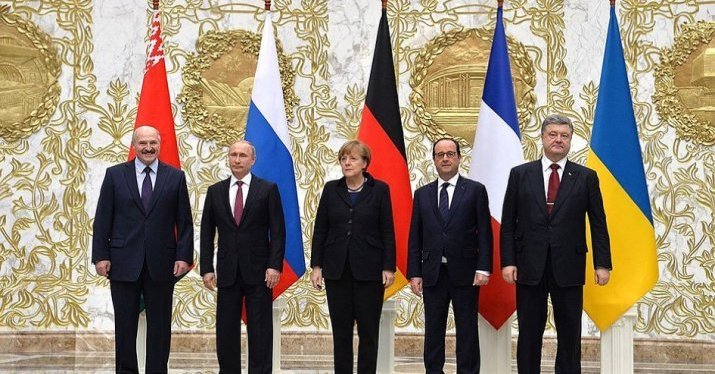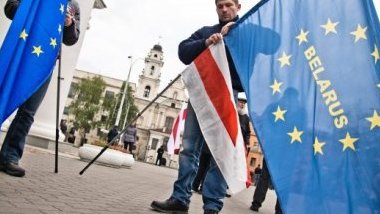The Baltic-European identity policy was inspired by the transition model in the Baltic states (in particular Lithuania) led by the Belarusian nationalists who were in power between 1991 and 1994. They did not gather the expected popular support due to the decline of the economic situation and the reluctance to reform.
The divide between conservatives and nationalists discredited the government’s policy, which eventually allowed Alexander Lukashenko to access power in 1994. He successfully combined a pan-Slavic discourse with the need to pursue an economic union with Russia so as to affirm the legal heritage of the Belarusian SSR and to enable an authoritarian drift by silencing the opposition as well as the civil society.
This evolution towards an authoritarian regime was bound to compromise the budding relationship with the European Union, especially since the EU had just devised the “Copenhagen criteria” for the accession of Central Europe, Eastern Balkans and Baltic countries. The EU also started to develop partnership agreements with non-EU countries while largely ignoring Belarus. What is the nature of the neighbourhood policy and what is Belarus’s part in it?
History of the European Neighbourhood Policy
After the collapse of the Communist bloc and its consequences in Eastern and Central Europe, the EU had to make sure of the transition towards democracy and market economy in the concerned countries. While the States wishing to access membership to the Union had to apply the acquis communautaire, other countries which had previously remained outside of the accession process were then able to sign the Partnership and Cooperation Agreements (PCA) in the fields of economy, trade and politics.
Because of the great Eastern enlargement on 1st May 2004, the EU had to rethink its neighbourhood policy as it would then share a border with rather unstable countries such as Ukraine (which was then caught in the midst of what preceded the Orange Revolution), or Moldova (the poorest country in Europe).
The European Neighbourhood Policy (ENP) was created in 2001 and decided by the European Commission in 2003. This relationship framework came in addition to pre-existing partnership agreements and reinforced the financial instruments (the ENPI - European Neighbourhood and Partnership Instrument- replaced the TACIS). Furthermore, the EU encourages a “personalized” cooperation with the 16 states covered by the PEV. Consequently, the Eastern Partnership was launched under the initiative of the Polish Minister of Foreign Affairs Radosław Sikorski.
The relative isolation of Belarus on the European stage
What about Belarus? Its relationship with the European Community goes back to the explosion of the Chernobyl nuclear power plant in April 1986, when the radioactive fallout contaminated Belarusian RSS territory. Thanks to Gorbachev’s openness policy, many Western NGOs – especially German ones – were able to go to the field in order to help affected populations. However, many projects were abandoned when the country’s hostility towards Western Europe began to grow.
Although a partnership and cooperation agreement was signed in 1995, it was never ratified because of the deterioration of the bilateral relationship. During a long time, Belarus was almost entirely excluded from European organizations; it is the only European country not to be a member of the Council of Europe and it was only included into the ENP in 2009 as part of the Eastern Partnership. The relationship remains limited due to sizeable differences of views regarding democracy and human rights. Common interests and objectives are therefore few and mutual mistrust persists (as between the EU and Russia).
Nevertheless, Belarus’ diplomatic isolation is moderate because of its close relationship with Russia. Alexander Lukashenko’s country is part of the Collective Security Treaty Organisation (CSTO), of the Eurasian Economic Union and above all of the Russia-Belarus Union, which can be perceived as Moscow’s plain and simple attempt to annex Belarus.
Is Belarus getting closer from the European Union?
Despite its very strong ties with Russia, it seems that Belarus is seeking to become closer to the European Union so as to assert its independence from Moscow.
Firstly, Moscow’s new irredentist policy (peaking with the unilateral annexation of Crimea in March 2014) frightened Minsk, which then attempted to be a mediator between Russia and Ukraine during the Ukrainian crisis (through the Minsk Forum). It thus showed to the international community (but above all to Vladimir Putin) that Belarus was not a Russian province.
Before the Ukrainian crisis, the relationship between the two countries was already tense since Moscow had made it known in Minsk that gas would be sold, from that point on, at regular market prices since preferential rates could not last forever and should never interfere with Russia’s economic development. Moreover, Alexander Lukashenko wanted to have a balanced relationship as part of the Russia-Belarus Union, and requested for the headquarters of the organization to be located in Minsk, which lacked in credibility, given the two countries’ respective geopolitical significance. The sticking points between the two governments have multiplied in the past ten years.
Henceforth, Alexander Lukashenko has had no choice but to tone down his anti-Western rhetoric. The first step in that direction was taken with the integration of Belarus in the Eastern Partnership alongside Ukraine and Moldova, two countries with a significantly more Europhile approach. Commercial relationships are developing and trade with the EU represents about a quarter of Belarus’ total trade. Given the country’s dependence to Russia, especially in terms of energy, the EU has become an essential trading partner. In 2016, the EU had lifted all economic sanctions against Belarus, except for weapons trade, in order to reward Alexander Lukashenko’s rapprochement policy. According to Brussels however, the situation regarding democracy and human rights remains very concerning.
ENP’s objectives have to be reviewed.
The relationship between the EU and Belarus is both too superficial and too new for conclusions to be drawn. The European Neighbourhood Policy has one major shortcoming: its main objective is cooperation with the EU’s Southern and Eastern neighbouring States, but they offer no prospect of accession, even in the long term. Yet, countries such as Ukraine, Moldova and Georgia all wish to eventually be integrated into the EU. The requirements for reforms in these countries expressed by Brussels without a compensation matching the expectations could prove to be counterproductive. Belarus currently does not intend to be a candidate for entry in the EU, though that could change in the coming years as the Eastern Partnership is taking shape and Russia’s influence is growing more pressing.




Follow the comments: |
|
